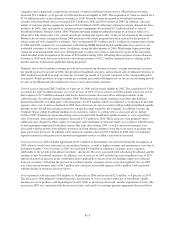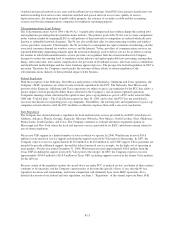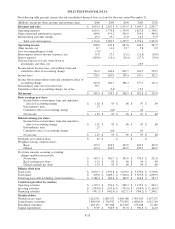Windstream 2006 Annual Report Download - page 123
Download and view the complete annual report
Please find page 123 of the 2006 Windstream annual report below. You can navigate through the pages in the report by either clicking on the pages listed below, or by using the keyword search tool below to find specific information within the annual report.
pension plan assets is based on a targeted asset allocation of 70 percent to equities, with an expected long-term rate of
return of 10 percent, and 30 percent to fixed income assets, with an expected long-term rate of return of 5.0 percent.
For the year ended December 31, 2006, the actual return on qualified pension plan assets was 13.7 percent. Lowering
the expected long-term rate of return on the qualified pension plan assets by 50 basis points (from 8.5 percent to 8.0
percent) would result in an increase in our pension expense of approximately $4.6 million in 2007.
The discount rate selected is based on a review of current market interest rates of high-quality, fixed-rate debt
securities adjusted to reflect the duration of expected future cash outflows for pension benefit payments. In developing
the discount rate assumption for 2007, Windstream reviewed the high-grade bond indices published by Moody’s and
Standard & Poor’s as of December 31, 2006 and other available market data and constructed a hypothetical portfolio of
high quality bonds with maturities that mirrored the expected payment stream of its pension benefit obligation. The
discount rate determined on this basis was 5.92 percent at December 31, 2006. Lowering the discount rate by 25 basis
points (from 5.92 percent to 5.67 percent) would result in an increase in our pension expense of approximately $2.2
million in 2007.
The Company expects to contribute $5.9 million to the Windstream plan during 2007 related to the plan formerly
sponsored by Valor as calculated in accordance with the minimum funding requirements of the Employee Retirement
Income Security Act of 1974. Future contributions to the plan will depend on various factors, including future
investment performance, changes in future discount rates and changes in the demographics of the population
participating in the qualified pension plan.
On August 17, 2006, the Pension Protection Act of 2006 (the “Act”) was signed into law by Congress. In general, the
Act changed the rules governing the minimum contribution requirements for funding a qualified defined benefit
pension plan on an annual basis without paying excise tax penalties. Among other requirements, the Act changed the
interest rates used to calculate lump-sum benefit payments and eliminated certain sunset provisions contained in the
Economic Growth and Tax Relief Reconciliation Act of 2001 (“EGTRRA”). EGTRRA increased the maximum
amount of benefits that a qualified defined benefit pension plan could pay and increased the maximum compensation
amount allowed for determining benefits for qualified pension plans. Windstream intends to comply with the Act in a
timely manner and does not believe there are any changes in the Act that have an immediate accounting implication,
nor does the Act trigger a significant event for the qualified defined benefit pension plan.
Other Postretirement Benefits
The Company provides postretirement healthcare and life insurance benefits for eligible employees. Retired employees
share a portion of the cost of these benefits. We fund the accrued costs of these plans as benefits are paid. In addition,
Windstream assumed certain obligations totaling $161.5 million from a postretirement healthcare plan formerly
sponsored by Valor. The Valor plan was merged into the Windstream plan effective December 31, 2006. Including
expense related to the former Valor plan from the date of acquisition, the Company incurred postretirement benefits
expense totaling $12.5 million in 2006, $16.7 million in 2005 and $14.5 million in 2004. Postretirement expense for
2007 is estimated to be approximately $24.2 million. After adopting the provisions of SFAS No. 158, $262.4 million
and $89.0 million at December 31, 2006 and 2005, respectively, of the postretirement benefits plan’s liabilities were
included in the other long term liabilities in the accompanying consolidated balance sheets.
We calculated our annual postretirement expense for 2007 based upon a number of actuarial assumptions, including a
healthcare cost trend rate of 10.0 percent and a discount rate of 5.90 percent. Consistent with the methodology used to
determine the appropriate discount rate for the Company’s pension obligations, the discount rate selected for
postretirement benefits is based on a hypothetical portfolio of high quality bonds with maturities that mirrored the
expected payment stream of the benefit obligation. The discount rate determined on this basis increased from 5.70
percent at December 31, 2005 to 5.90 percent at December 31, 2006. Lowering the discount rate by 25 basis points
(from 5.90 percent to 5.65 percent) would result in an increase in our allocation of postretirement expense of
approximately $0.5 million in 2007.
The healthcare cost trend rate is based on our actual medical claims experience and future projections of medical costs.
For the year ended December 31, 2006, a one percent increase in the assumed healthcare cost trend rate would increase
our postretirement benefit cost by approximately $0.7 million, while a one percent decrease in the rate would reduce
our allocation of postretirement benefit cost by approximately $0.6 million.
F-22
























